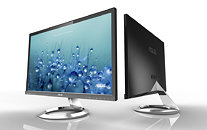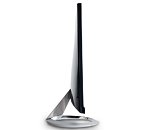Monday, September 3rd 2012

ASUS Outs Designo Series IPS LED Monitors
ASUS introduced its newest line of stylish consumer PC monitors under the Designo series. It includes 23-inch MX239H and 27-inch MX279H models, most likely featuring native resolutions of 1920 x 1080 and 2560 x 1440, respectively. The two feature a design which ASUS claims to be "inspired by sundials." Living up to the idea, the design consists of a combination of curves and sharp angles. The most distinct feature is slim bezels around the panel.
At the heart of the Designo series is IPS LCD panels with edge LED illumination. The illumination source is at the edges of the panel, an arrangement that reduces power consumption even further down from conventional LED-backlit LCD monitors, and older CCFL-lit LCDs. Both monitors feature dual-HDMI inputs and Bang & Olufsen ICEpower speakers. The company did not give out pricing information.
Source:
FlatpanelsHD
At the heart of the Designo series is IPS LCD panels with edge LED illumination. The illumination source is at the edges of the panel, an arrangement that reduces power consumption even further down from conventional LED-backlit LCD monitors, and older CCFL-lit LCDs. Both monitors feature dual-HDMI inputs and Bang & Olufsen ICEpower speakers. The company did not give out pricing information.


24 Comments on ASUS Outs Designo Series IPS LED Monitors
www.youtube.com/watch?v=3h6S1CapH98
For normal usage, the human vision system require a latency of 10ms - 15ms from when the an image is captured to when it's realized by our brains. So having more frames rendered per second will not make the animation look smoother. 75hz - 80hz is all we need to get the best and smoothest form of animation.
As for the monitors, if it does well in the color accuracy, contrast ratio, input lag, and pixel transition times tests, then heck, the 27" one could become my next monitor.
I'm sure someone can link the thread.
Write something on the palm of your hand, and then, start moving your hand up and down slwoly while you're staring at it. Can you read clearly what's on your hand? You can do the same test with a picture.
You will in fact see the so-called GHOSTING effect that we are familiar with on LCD monitors.
That means your vision will be blurry and you'll see a kind of trail left behind due to the fact that your eyes don't look long enough at the picture to capture all the visual information off the image, so the brain doesn't get all the visual data that's needed to see the image properly.Let's call this the capture time latency.
Add to that the amount of time it takes for you brain to process the image (let's call this the input latency), and you get the human eye latency (that's what i call it).
What does that mean? It means that updating images at a speed that's higher than the human eye latency will not result in smoother animation. Meaning, if the image update time is lower than the capture time latency, you'll get ghosting and a blurry animation. And if it's higher than the capture time latency but lower than the human eye latency, then you'll not see it the instant it's put on the screen cuz you're brain will be still working on processing the previous image.
The human eye latency, which is the sum of capture time latency + input latency, is around 12-13 ms on average. So having anything higher than 80Hz refresh rate is pointless.
As for 120hz and IPS, turns out those overclocked ones were frame skipping beyond 82hz or so.
Secondly....really? 27inch+IPS+120hz?, how much money are you willing to spend (better off getting those monitors meant for gaming)
Please, take your False information somewhere else. What you are describing in no way translates to how the images on a progressive scan LCD work. You examples are completely ignorant to the way our eyes handle the sight of moving images let alone an progressive LCD screen.
I own an PCBANK 2560x1440 ips, a 60 Hz 23" Asus 1080 and a benQ 24" 120hz 1080 xl2420t and will tell you that the ips has the best image while the 120hz has the best movement and reaction. The immersion itself from the 120hz is amazing to behold and probably the best upgrade I have made. It brings a whole new level to gaming honestly
Like the other posters excellently pointed out, the difference in daily use between a 60 Hz monitor and a 120 Hz monitor is like day and night. So before judging a technology that is clearly superior than what we have now, try it out first before spouting crap out of your mouth. :)
Waving your hand means that you get a real time animation test looking at a moving object.That's the same kind of test that's used to test pixel response time at tftcentral and anandtech (the PixPerAn test).
If the movement speed exceeds a specific limit, you lose clear sight of whatever is written on your palm, or moving (a car in the PixPerAn test), and that's ghosting.
See and identify planes at 700 flashes? That's some big bs. You clearly don't know what you're talking about. Less than 5% of humans have a eye latency time that's less than 12ms. This means that from the instant an image is displayed, it will take the average human 12 - 15 ms to see the image. Anything faster than that will not make any difference at the least and might end up reducing the smoothness of the animation.
And yes, I'm using a dual monitor setup. A Samsung S23A750D 120Hz monitor alongside a LG W2242TQ 60Hz monitor. I don't notice any difference between the two in L4D 2.
beaten to death.
no, you are fail for expecting that
It is possible to have a car as fast as a bugatti Veyron. Yet Ferrari isn't fail for not having a car that fast.
The technology is there to make 2880x1600 or wtv 15" screens. Is every new laptop that doesn't have that screen fail?
Stop being idiots saying "no ips = fail, no sub 400$ like monitor from Korea = fail" Theres always a better product somewhere, instead of complaining that this monitor aint the best thing in the universe, go buy the one that is... oh you dont want to pay that price? Get over it then
Noone is forcing you to buy this monitor